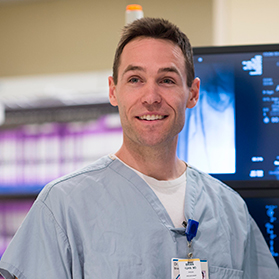- Community & News
- Heart
- Patient Stories
- Service Line
Understanding Abdominal Aortic Aneurysms

Abdominal aortic aneurysms, or AAA, affect 5 to 7% of the population aged 60 or older, and are four times more common in men than women. With 15,000 AAA-related deaths occurring every year, it’s important to know the warning signs and be proactive with your health.
Brian Kuhn MD, a vascular surgeon with the TriHealth Heart & Vascular Institute, explains AAA risk factors, symptoms and treatment options.
What is AAA?
The aorta is the largest artery in our body and is responsible for carrying blood to the abdomen, pelvis and legs. When the aorta enlarges or balloons, it is known as AAA.
Due to slow growth and little to no symptoms, abdominal aortic aneurysms are often hard to detect. They can develop in anyone, but are most commonly seen in men aged 60 or older. “There are many risk factors that can contribute to AAA, but one of the most significant is family history,” Dr. Kuhn says.
Additional risk factors include:
- Emphysema
- Atherosclerosis
- Genetic factors
- High blood pressure
- High cholesterol
- Obesity
- Smoking
AAA Symptoms:
Over time, as the aneurysm develops and enlarges, you may experience a pulsating feeling around the naval and pain in your abdomen and back. If the aneurysm ruptures or causes internal bleeding, additional symptoms may come on quickly. Symptoms to be aware of include:
- Pain in the abdomen or back — may spread to the groin, buttocks, or legs
- Clammy skin
- Dizziness
- Nausea and vomiting
- Rapid heart rate
- Shock
If you fall into a high-risk category, it is important to talk with your doctor about regular screenings for AAA. Your doctor will examine your abdomen, and may perform additional tests if he or she suspects AAA, including:
- Angiogram
- Abdominal CT scan
- Abdominal ultrasound
Treatment and Prognosis:
If an aneurysm is discovered, multiple treatment options are considered depending on the size and severity. For smaller cases, surgery might not be necessary. Rather, an ultrasound every six months to monitor the size may suffice. “If treatment or surgery is needed, 80 to 90% of cases can be performed using a minimally invasive manner, being percutaneous with stents,” Dr. Kuhn explains.
When an abdominal aneurysm tears or ruptures, the condition is elevated to a medical emergency, with less than 80% of patients surviving. If caught early and monitored regularly by your doctor, abdominal aneurysms can be repaired with a positive outcome for the patient. Be proactive with your health and talk with your doctor about your risk factors for AAA development.
Related Articles
- Health & Wellness
- Primary Care
- Service Line
- Women's Health
- Community & News
- Heart
- Patient Stories
- Service Line
- Treatments